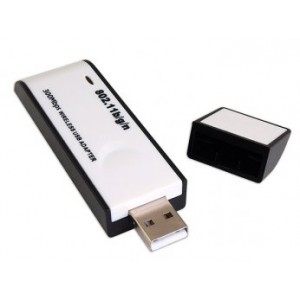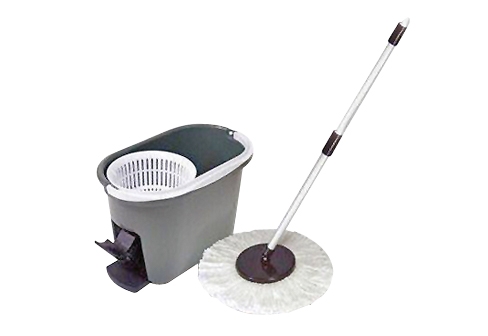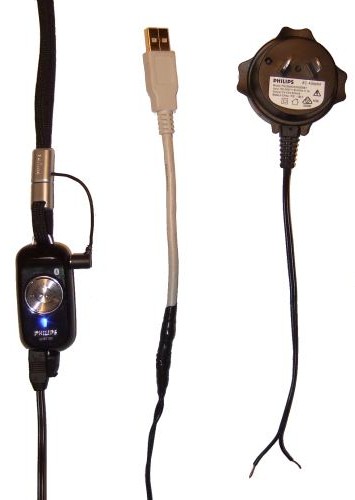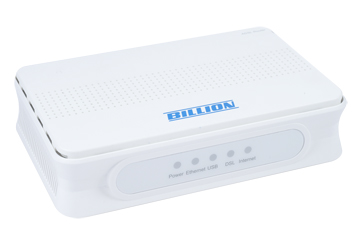USB Wireless N Adapter Transfers At Up To 300Mbps
Written by Vlad on September 2, 2010 – 7:59 pm - 2,619 views
This is a generic-branded USB Wireless N adapter based on the Ralink RT3072 chipset. It can transfer at up to 300Mbps, unlike commonly found less-capable models that only support 150Mbps. It is also compatible with older 802.11g and 802.11b networks. It is supported under Windows XP, 2000, Vista, Windows 7, Macintosh and Linux.
I bought it for $25.90 from GoodBargain.com.au.
Why I Bought the USB 300Mbps Wireless N Adapter
My old Dell Inspiron 6000 Laptop and my Asus EEE PC 701SD netbook only have built-in 802.11g networking. I recently upgraded my Wireless Router from an Asus WL-500gPv2 (100MB Ethernet and 802.11g) to an Asus RT-N16 (Gigabit Ethernet and Wireless N). Using this USB Wireless N adapter, I can take advantage of the faster Wireless N speeds on those systems.
Tips for getting the best performance from Wireless N
Wireless N Background
To understand how to get best performance, we must explore a few concepts about how Wireless N works. Much of the speed increase for Wireless N (formally known as 802.11n) compared to Wireless G is due to:
- Doubling the channel bandwidth from 20MHz to 40MHz
- Using MIMO technology, where multiple antennas can be used at each end to send and receive signals along multiple spacial paths, up to a maximum of 4.
- Being able to use larger and less congested 5GHz frequency band in addition to the crowded 2.4GHz frequency band that is shared with Wireless G, Wireless B and Bluetooth
Note that these features do NOT have to be implemented in a networking device in order for it to be Wireless N compliant – they are optional, but the more of them that a Wireless N device has, the faster it can go. Likewise, the speed of a wireless N network connection between any two nodes will be limited by slowest device.
Ralink RT3072-based USB Wireless N adapters support a 40MHz channel bandwidth on the 2.4GHz frequency band and MIMO with two spacial channels, yielding a top speed of 300Mb/s. To achieve this speed:
Make sure your Wireless N router and Wireless N adapters support 40MHz operation on the 2.4GHz band
The 802.11n (Wireless N) standard allows devices to operate on either the 2.4GHz band or the 5GHz band. In practice, most Wireless N devices on the market only support the 2.4GHz band, simply because it makes the device cheaper to manufacture, backward compatible with earlier standards, and because 2.4GHz signals have a longer range than 5GHz signals. Unfortunately, the 2.4GHz band is very congested, as most WiFi networks and Bluetooth devices use it. The 5GHz band is bigger and relatively quiet.
Most adapters and routers support a 40MHz channel bandwidth, but some don’t allow it to be used on the 2.4GHz band – Intel Centrino and Wifi-Link Wireless N adapters come to mind. If these devices are forced to use 20MHz, then your top speed will be halved. You may have to log into the administration interface of your router to enable 40MHz operation. You may also have to change adapter configuration settings.
Beware that enabling 40MHz will hog most of the available channels on the 2.4GHz band. This may pose a problem if you have a lot of networks in your area, as your channels will overlap with theirs. This means that you will slow them down and they will slow you down. You may find that you are better off running at 20MHz if you can get a quieter chunk of spectrum.
Make sure your Wireless N router and Wireless N adapters support MIMO with two or more spacial channels
Most Wireless N routers will support MIMO with 2 or 3 spacial channels. Adapters vary more in what they support. You can usually work out the number of spacial channels by examining the top speed of the device. Each spacial channel running at 40Mhz has a maximum speed of 150Mb/s, so MIMO with 2 spacial channels gives you a top speed of 300Mb/s and a 3 spacial channel device has a top speed of 450Mb/s.
Note that the number of antennas a Wireless N device has does NOT always equal the number of spacial channels it supports. There are Wireless N routers and adapters that use different numbers of antennas for transmitting and receiving.
For example, a Wireless N Adapter advertised as 1T2R uses only one antenna for transmitting and 2 antennas for receiving. If such an adapter is advertised as having a top speed of 300Mbps, you will only get that top speed when receiving data. The transmission speed will be limited to half that (150Mb/s).
Ralink RT3072-based adapters support 2T2R operation, so two antennas are used for both transmitting and receiving and you can get up to 300Mb/s in both directions.
Other Uses for the 300Mbps USB Wireless N Adapter
Making your own range-extending directional antenna
People often use USB WiFi adapters to build low cost high-gain directional antennas. These are used to:
- Extend the range of a wireless network over a long distance – often distances of several kilometres have been achieved
- Access a public WiFi hotspot from further away
- Determining the location of WiFi devices in a certain area
With the the Ralink RT3072 USB Wireless Adapter, you can run it at high speed.
All you need is an old metal Wok, mesh strainer, or anything that is metal and shaped like a parabolic dish. You then mount the USB wireless adapter at the focus point, and connect it to your computer with a long USB cable. Complete instructions can be found on the following sites:
- http://www.usbwifi.orconhosting.net.nz/
- http://www.ehow.com/how_6805211_make-wifi-antenna-usb-cable.html
Tags: 802.11n, networking, Ralink, RT3072, USB, WiFi, wireless
Posted in Computer Hardware | 1 Comment »







By Alex on Sep 9, 2010 | Reply
Great article Vlad. Very informative.
What will you buy next??